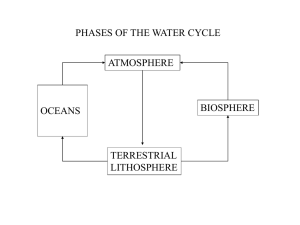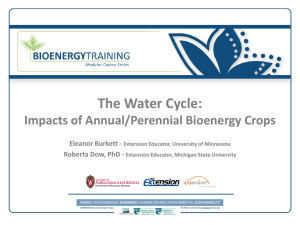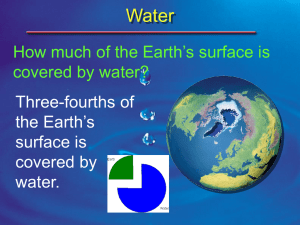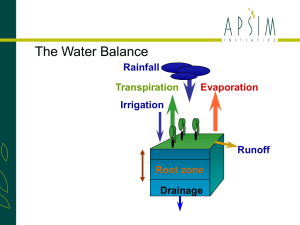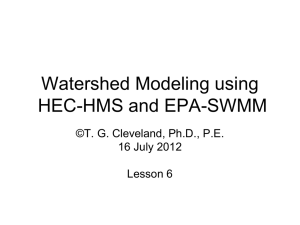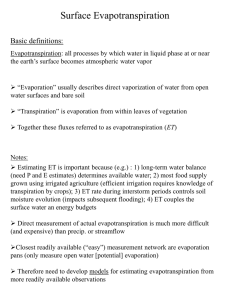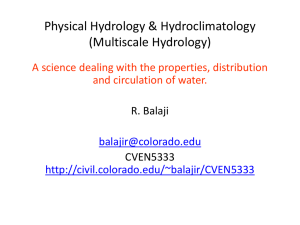An Introduction to Water Budget Equation
advertisement
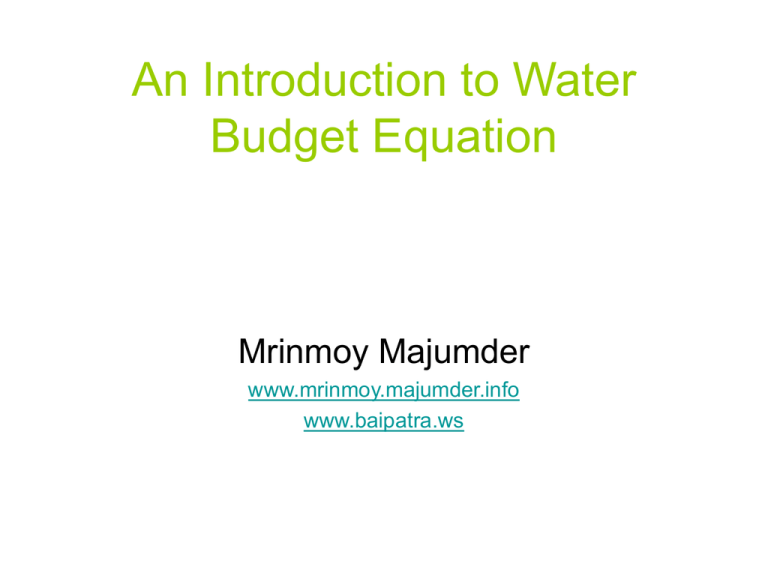
An Introduction to Water Budget Equation Mrinmoy Majumder www.mrinmoy.majumder.info www.baipatra.ws Hydrologic Cycle Source of Energy Transpiration (T) Precipitation (P) Canopy Evaporation (Ec) Soil Evaporation (Es) Evaporation (E) Surface Runoff (Q) Sub-surface Runoff (Qss) Infiltration (I) Ground Water Outflow (GWO) Ground Water Storage Precipitation Precipitation is any form by which condensation of atmospheric water vapor is pulled down by gravity and deposited on the Earth's surface. Causes of Precipitation or Weather System for Precipitation Different Forms of Precipitation Raindrop : Common in tropical zones and lower elevation areas. Raindrops are formed due to the condensation and coalescence process. Water droplets above freezing temperature, due to turbulence in the air, collides with each other to form larger droplets. When mass of the droplets become larger than the resistance of air to gravity, those droplets fall to ground as raindrops. Ice pellets : If sub-freezing layer is present in both below and above an above freezing layer raindrops are converted to crystals of ice before reaching the ground as the cold layer, below the warm re-freezes the raindrops into ice. Hail : Hail forms in storm clouds when super cooled water droplets freeze on contact with dust or dirt. The storm's updraft blows the hailstones to the upper part of the cloud. The updraft dissipates and the hailstones fall down, back into the updraft, and are lifted up again. The hailstone gains in ice layer and grows increasingly larger with each ascent. Once a hailstone becomes too heavy to be supported by the storm's updraft, it falls from the cloud. Snowflakes : Snow crystals form when tiny super cooled cloud droplets (about 10 μm in diameter) freeze. Drizzle : Rain-droplets of size less than 0.5 mm and rain intensity of less than 1mm/h is known as drizzle. Glaze : When rain or drizzle touches ground at zero degree centigrade, glaze or freezing rain is formed. Front : Front is the condition when two distinct mass of air meets with each other and the warmer air moves up above the cold air.In the time of ascending, the air is adiabatically cooled and creates cloud and subsequent precipitation. Cyclone : A large low pressure region is known as Cyclone. Tropical – When the diameter of the low pressure region is 100200km,centre is 10-50km in diameter and if in the tropics, the cyclone is known as Tropical Cyclone. Heavy rainfall and wind speed of 119km/hr can be observed in the region. The intensity of the storm decreases with the distance from the eye or center of the cyclone. Extra-tropical – Cyclones that form outside the tropical zone and are associated with a frontal system is called as Extra-tropical Cyclone. The circulation of wind is counterclockwise in the northern hemisphere. Though magnitude of precipitation and wind velocity is smaller than the tropical cyclones. The intensity of the precipitation is low but the duration and extent of the low pressure region is larger than the former. Anticyclones : A region of low pressure with moderate wind speed and clockwise wind circulation is called as Anti-Cyclone. Convective Precipitation : Localized warming can form a warm air mass surrounded by a cooler one. The warmer mass moves up and form convective clouds and subsequent precipitation. Areal extent of such precipitation is small. Orographic Precipitation : The warm, moist air moves up in the windward side of the mountain barriers and undergo cooling, condensation and Orographic Precipitation. Leeward slopes of the barrier faces lighter rainfall than the other side. Evaporation Evaporation(E) can be defined as the change of state due to the change in kinetic energy of the water molecules at the surface of a water body. The change is caused by energy derived from the sun and depends on vapor pressure (ew), atmospheric pressure, wind (w), temperature (T), soluble salts ,heat storage in and size (A) of the water body. Factors of Evaporation Types of Evaporation E is proportional to : ew,T,W and A Evaporation from water stored in the pores of the soil,i.e.,soil moisture is called as Soil Evaporation E is inversely proportional to : Atmospheric pressure and soluble salts. Presence of dissolved salts decreases evaporation. Evaporation from tree canopy is Canopy Evaporation. Heat Storage Deep lake can store more heat energy than shallow lakes. That is why former store more heat than the latter. Which causes more evaporation in winter than summer for deep lakes. Total Evaporation from a catchment or an area is the summation of both soil and canopy evaporation. Transpiration Transpiration can be defined as the evaporation of water from the leaf stomata or extraction of excess water produced due to photosynthesis. About 70 percent of all rainfall returns to the atmosphere in the form of evaporation and transpiration. In irrigation and hydrologic practice Evaporation and Transpiration is considered under one head which is called as EvapoTranspiration. Field Capacity is the maximum capacity of soil to store water that can be extracted by plant for their food preparation. Wilting Point in the other hand is the point below which plant can not extract the water stored in soil pores. The difference of Field Capacity and Wilting Point is called as Available Water, i.e., moisture available for plant growth. Water Transpirated Retrieved From http://www.fijiaquifer.com/transpiration.htm Runoff Runoff is defined as that amount of water which travels either surface or subsurface and releases into channels, lake or streams. Runoff is actually the sum of overland flow (OF), Saturated Excess Overland Flow (SEOF), Interflow (IF) or Sub-Surface Flow and Base Flow (BF). Now, Direct Run Off = OF+IF+SEOF Retrieved From http://www.co.portage.wi.us/groundwater/undrstnd/runoff.htm Surface Runoff = OF+SEOF and, OF = That part of precipitation that flows overland and falls into a stream/lake etc. after soil capacity becomes full with infiltrated water. SEOF = During or after precipitation, once the capacity of soil layers become full, the excess water flows overland into the adjacent water body. The part of water is known as SEOF. IF = The water that travels through the vadose zone of soil layers which can not reach the ground water level and discharges into adjacent water body. BF = Base Flow is the amount of flow that recharges the adjacent water body if the level of water of the stream/lake falls below the nearest ground water table. Ground Water 1 3 2 4 Retrieved from http://community.boredofstudies.org/19/senior-science/209691/revision-study-notes-water-plants.html After precipitation, pores in the soil layer, under the surface becomes divided into two distinct zone. The layer which becomes saturated with infiltrated water, is called as zone of saturation(2) and the other layer is referred as zone of un-saturation/aeration or vadose zone(1).The water pass through the unsaturated zone into the saturated zone and recharge the existing ground water storage. If this zone is confined by impervious layers then the zone is known as confined aquifer and if one or more side is open, unconfined aquifer.Water table (3) is the upper level of the water stored in the aquifer.If water table is less than water level of the adjacent water body and if pores of sufficient size and frequency is available ground water will leech into the water body (Affluent) and if the table is lesser than the water level recharge of ground water will take place (Effluent). The excess water from zone of saturation releases to adjacent water body as ground water outflow(4). Infiltration Infiltration can be defined as that part of the hydrologic cycle where water seeps through the soil and after saturation of soil layers, recharges the ground water storage which is known as Percolation. Infiltration is loss to runoff but gain to ground water. Precipitation Infiltration capacity or amount of infiltration depends on soil type, surface of entry and fluid characteristics. Soil Type : A loosely fit soil like sand with high porosity will have greater infiltration than a closely fit soil like clay with low porosity. A soil with adequate under-drainage which can take the infiltered water away from the point of entry will have more infiltration than the soil which doesn't possess an under-drainage. Surface of Entry : Infiltration capacity also depends on the moisture content of soil. If soil pores are already filled with water capacity of the soil to infiltrate will greatly reduce. Also if the surface is covered by leafs or impervious materials like plastic, cement then seepage of water will be blocked. Fluid Characteristics : Water with high turbidity or suspended solids will face resistance during infiltration as the pores of the soil may be blocked by the dissolved solids. Increase in temperature can influence viscocity of water which will again impact on the movement of water through the surface. Infiltration Soil Moisture Storage Capacity Percolation Ground Water Storage Initial Loss Interception Loss When water after precipitation is retained by vegetation as surface storage then it is referred as interception loss. Generally 10-20% of annual total rainfall is taken as loss due to interception. Depression Storage When water is trapped in the surface depressions then it is called as Depression storage. Loss of water by depression storage and interception loss, both are called as Initial Loss. Interception Loss is mainly caused by evaporation from the water retained by the vegetation whereas water stored in depressions depend upon soil type, surface, slope and soil moisture. Water Budget Equation At a specific duration of time and at a reference temperature and density, from the continuity equation change of storage within a specific command area can be determined as : Mass Inflow – Mass Outflow = Change in Mass Storage Or, From Hydrologic Cycle, P – Q – GWO – E – T = Change in Storage of Water WATER BUDGET EQUATION All terms in dimension of volume or in depth. As infiltration is loss to runoff but gain to ground water storage, it is not represented explicitly. For a given problem ,multiply area with P,E and T; Add Ground water storage with change in storage to get the total water available.
